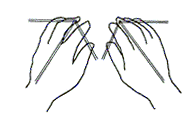4. The design that overcomes these
shortcomings
From the above study, the ergonomic keyboard design that deals with the
shortcomings of the normal keyboard and the conventional ergonomic keyboard
must create a difference in level between the surface of the thumb and index
finger keys and those of the middle, third, and little finger keys, while
retaining the usual key layout.
The solution is very simple, but it is obtained as a conclusion of the above study.
Let me explain the preceding clause 3 (Points 1, 2, and 3) once more.
■(Point 1)
The middle, third, and little fingers are situated on the horizontal plane.
 Because the tips of these fingers are situated on the horizontal plane, the key surface should be horizontal accordingly. No inclined key surface design is required. Because the tips of these fingers are situated on the horizontal plane, the key surface should be horizontal accordingly. No inclined key surface design is required.
If the key surface is inclined, users will have to rotate their hands/forearms
outward to strike the little finger key.
■(Point 2)
When both forearms are located in the inverted V shape, the tips of the
middle, third, and little fingers are located on the straight line of the
conventional key layout.

You can place the tips of your middle, third, and little fingers on the normal key layout by adjusting the angle of both forearms. No V-shaped key arrangement is required.
The V-shaped key arrangement might have been necessary when the large CRT display dominated the desk and the keyboard had to be set close to your body, in which case you pulled your elbows behind while typing.
These days, however, there is vacant space on the desk due to the slim LCD, and we no longer pull our elbows behind. We can easily place the tips of our middle, third, and little fingers on the normal key layout position by simply adjusting the distance between the keyboard and our body.
■(Point 3)
The tips of the index finger and thumb are floated.
 The remaining problem is how to evade the "twist" operation at
the wrist. Now we can explain the reason why the twist operation at the
wrist causes stress from the viewpoint of anatomy. The remaining problem is how to evade the "twist" operation at
the wrist. Now we can explain the reason why the twist operation at the
wrist causes stress from the viewpoint of anatomy.
The reason why we have to rotate our hands/forearms inward and bend the
wrist to reach the keys (as seen in Chapter 1) is because the fingertips
of the index finger and thumb are floated in the natural hand posture.
The way to settle this problem is to make the specific key surface for the index finger and thumb close to the original position of the “floating” fingertip of the index finger and thumb.
The resulting minimal movement of the tips of the index finger and thumb will minimize the occurrence of the twist (rotate and bend) action.
This conclusion is simple; however considering its compatibility with the normal keyboard, it is sufficiently comfortable for typing.

|